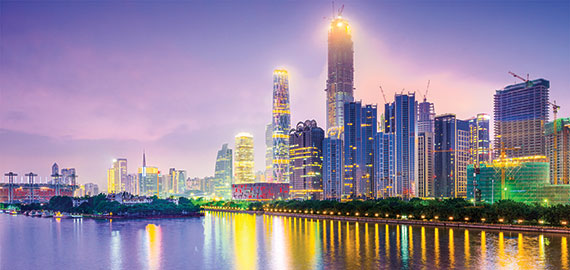Could a world led by global cities, rather than nation states, be the answer to geopolitical turmoil and inequality? And how should the property sector make it a reality? Karl Tomusk considers the arguments
Imagine a world where countries have disappeared, their borders purged from a globe glistening with grids zigzagging from city to city. Cables and pipelines, railways and highways connect mass urban clusters that light up whole continents no longer strangled by hostile geopolitics.
 It will be the age of the master builder. Their designs will either help usher in an era of peacemaking or will let the globe descend into uncontrollable slums steeped in conflict.
It will be the age of the master builder. Their designs will either help usher in an era of peacemaking or will let the globe descend into uncontrollable slums steeped in conflict.
This is the world Parag Khanna, an international relations analyst and best-selling author, predicts in his new book Connectography: Mapping the Future of Global Civilization. “A century ago, people believed that trade interdependence between countries would lead to more stable relations, and yet the first world war did break out,” he says.
The difference now is that on top of trade interdependence, we have more financial and supply connectivity from nation to nation, even between rivals. Hundreds of US companies from Apple to General Electric manufacture products in China, while about 40% of Taiwan’s exports go to the Asian superpower. The two nations once torn apart by the Chinese civil war now have hundreds of direct flights every week, where only 13 years ago not a single commercial plane flew between them.
In short, the wind is changing. And masterplanning and urban design have never been more powerful.
Building bridges
Cities, Khanna argues, are at the heart of co-operation between countries and continents because they care more about economic integration than territorial expansion. Ideally, he says, cities can come together and think: “Let’s make the most of our functional geography, rather than the political geography that divides us.”
In 1989 Singapore did just that when it established an economic partnership with Johor in Malaysia and the Riau Islands in Indonesia, called the SIJORI Growth Triangle. The plan was to balance out each other’s resources. Singapore’s capital and technological expertise would work with Malaysia’s and Indonesia’s abundance of land and labour to create a unified economic region unrestricted by political divisions. It has led to Singapore investing $50bn (£34.5bn) in Johor, buttressing its textile and electronics industries, and pouring money into construction in Malaysia as it builds bridges connecting the two.
Meanwhile, more metropolitan areas are also physically spilling over political boundaries, uniting otherwise separate countries – a phenomenon that is becoming more common on the US-Mexico border. San Diego and Tijuana, for example, share a metropolitan area with a population of more than 5m. The two cities are markedly different, however. They share a similar population size, but whereas San Diego is a sprawling city, Tijuana squeezes its residents into a space six times smaller. While some in Tijuana move north and assimilate into San Diego, the poorest in the city build slums with pieces of San Diego’s abandoned or broken buildings, which have been transported across the border and recycled into makeshift living spaces.
But integration is happening. The two cities already share an airport terminal on the border, and architects such as Teddy Cruz at the University of California, San Diego, are working with cities to develop cross-border infrastructure and regional co-operation. The scheme, called the Bi-national Citizenship Culture Survey, studies people’s needs on both sides of the border and will be used as a way to establish a shared council for the cities. The idea is to transcend what they call the “identitarian politics of the nation-state”, focusing on the joint metropolitan area and fixing its still rampant inequality, not the national border that divides it.
The rise of the megacity
As megacities are growing rapidly, with 40 or more expected to colour the globe by 2030, and the influence of urban clusters extends far beyond their national borders, the same practical role the architects in San Diego-Tijuana are playing should extend to every urban area.
For Khanna, the priority is functional infrastructure and the economy: a city cannot play a solid global role if its residents lack access to basic services or are shunted into ungoverned slums with no opportunities. This is particularly important as cities, according to UN estimates, prepare to grow and house two-thirds of the world’s population by 2050.
“This should be the age of the master builder and the urban planner, but that is not to say they should be celebrity architects,” Khanna says. “It should be the age of 3D printed designs for affordable housing on a large scale, and it should be the age of sewage treatment plants and water desalination, and the age of commuter railways and public transportation.”
Khanna points to Kabul as an example of what can happen if basic infrastructure is missing. Military interventions, he says, have placed too much emphasis on political goals and not enough on building cities from the bottom up, leaving them a divided mess. The 1.6-mile Salang Pass Tunnel, which connects the north of Afghanistan to the capital, had been neglected for years until the World Bank invested $250m into repairing it last October.
Southern Afghanistan has had a similar infrastructure failure, as the Kajaki Dam, which could power the region, has remained incomplete, plagued by delays and intermittent fighting. Afghanistan as a whole, meanwhile, is still a hotbed for insurgency; something Khanna does not think will end as long as its cities remain broken and isolated.
In Colombia, however, the city of Medellín flaunts the power of urban planning. In the early 1990s, when drug lord Pablo Escobar was in power, it was by far the most dangerous city on earth: slums upon slums brimming with residents who felt no connection with Medellín experienced more 6,000 homicides a year – 381 per 100,000 people. Following a 1998 Colombian law that required every city to have an urban masterplan, city planners began to work with communities to develop the infrastructure they needed. Soon, cable cars and a metro system – the first one in Colombia – were built, uniting the slums with richer parts of the city. Public libraries and other meeting places popped up in poor areas, all of which started to foster an identity for Medellín as a whole, rich and poor.
While homicide rates are still relatively high – 20 per 100,000 people reported last year – they are nowhere near the level they were just a few decades ago, nor anywhere near the 50 highest in the world. Giving the people the infrastructure they needed arguably revolutionised the world’s former homicide capital.
The implications of Medellín’s renewal were reaffirmed in a 2013 study into anti-Semitism from Birkbeck, University of London and the University of Oxford, which found that marginalisation feeds extremism of all forms.
Whether through inequality or discrimination, groups that feel separate from the rest of society are more likely to turn to extremism as a way to explain and react to their plight.
For Jerome Frost, global cities leader at planning consultancy Arup, this is what makes London’s diversity an example of the potential cities have. Noting the capital’s diversity in the wake of Sadiq Khan’s mayoral election win, he says: “The more multi-ethnic a city, the more resilient it is and the more able it is to resist extremism. We have seen that in London following the attacks in 2005. The city always bounces back and rejects extremism.”
Breeding confidence
Frost says a key part of Arup’s masterplans involves finding ways to cultivate integration and confidence for everyone in a city. “A successful city is one which can breed confidence in its stability for international and national investment to be channelled into it. This is bred not just through the stability of government but also the mindset of the people that live there, that they are prepared to invest in a place they see as having a long-term, stable future.”
The firm has worked in conflict areas as diverse as post-apartheid Pretoria, Palestine, and Croydon following the 2011 London riots. In Palestine, it consulted on the Bethlehem Development Initiative, which since 2012 has worked to turn the city into an “international spiritual and touristic destination” while improving basic infrastructure. Like in San Diego-Tijuana, the political differences that divide the city are put aside to focus on the practicality of what people need.
In a way, the ongoing project, which works with all the major religious communities in the area, is an experiment.
“A private developer, Said Khoury, had taken it upon himself to look at whether a development on the boundaries of different communities could broker a more stable environment as a place to live and work,” Frost says. This includes improving streets and public transportation so none of the three parts of the city, Beit Jala, Beit Sahour, and Bethlehem, are isolated; providing affordable pre-schooling; and improving basic services such as waste collection and access to clean water.
Unfortunately, as the European Council on Foreign Relations is quick to remind us, even perfectly planned and integrated cities cannot solve the world’s conflicts, partly because we still live in a reality where nation-states exist and have power. According to Ulrike Franke, a researcher at the ECFR, countries can exploit the same resources and networks that connect and integrate cities.
“All over the world, countries realise they get power, leverage, out of the fact that they are part of this international system. The more connected you are in this system, the more powerful you become,” she says. It becomes a race to become “the new Rome”, to have every road lead to your country.
But while some countries have been able to diversify and become “Rome”, supplying multiple trade partners with resources no one else can, others have become dependent on a single power. In Angola, for example, oil accounts for 90% of government revenues and it exports half of that to China, giving China disproportionate leverage in their partnership.
Systems like this are why countries from the EU to the US to India have been able to use sanctions to manipulate countries dependent on them. As armed conflicts have given way to economic battles, Franke says what was once mutually assured destruction has now become mutually assured disruption.
Of course, the hope is that this becomes less common as cities grow and work past their geopolitical divisions: that there will be more Medellíns stabilising from within and more SIJORI Growth Triangles co-operating abroad.
As the world deals with its inevitable urbanisation, cities have to become spaces where internal and international peace is achievable, and architects have to know how to build that. As Khanna considers his view on urban development, his position is clear: “The hardware has to come first.”
Pearl River Delta
The Pearl River Delta, a region in China with nine cities stretching from Guangzhou to Macau and Shenzhen, is a special economic zone at its most powerful. Having greater power to set its tax and trade policies has made the urban cluster boom, with foreign investors scurrying to do business there. By 2030, the region is expected to become one giant megalopolis with a population of 80m and a GDP of $2tn. Already more than 500,000 people cross the border to and from Hong Kong every day, which will only increase once the Hong Kong-Zhuhai-Macau Bridge is complete.
Lagos
With its estimated $91bn GDP putting it above 42 countries in Africa, Nigeria’s largest city is a regional powerhouse in the midst of connecting itself with its neighbours. A major rail development is under way that will eventually span four countries from Lagos to Abidjan in the Ivory Coast. The African Development Bank is promoting the Abidjan-Lagos Corridor as a sure-fire way to skyrocket trade and spread wealth and stability in what it hopes will become a global economic player.
King Abdullah Economic City
If you need a city to act as a global centre rivalling Dubai and can summon up $100bn, the logical step is to build one from scratch. That is what Saudi Arabia is doing with the King Abdullah Economic City – or KAEC (pronounced “cake”) – a project funded entirely by private sector foreign investment. It is an attempt to diversity the country’s economy, attract manufacturers with its port and build a functional residential area for the 2m residents it hopes to bring in by 2035.
C40
Global cities with a global influence give their leaders a global platform, which is where the C40 Cities Climate Leadership Group comes in. Uniting 83 cities from six continents, C40 gives mayors the chance to discuss how they can tackle climate change on a local level. It puts cities in a unique position where they can find ways to fix global problems in their jurisdiction, on behalf of their nations and the world. It is a process that Vanesa Castan Broto from UCL’s development planning unit describes as: “Local governments helping national governments to achieve their international commitments.”












